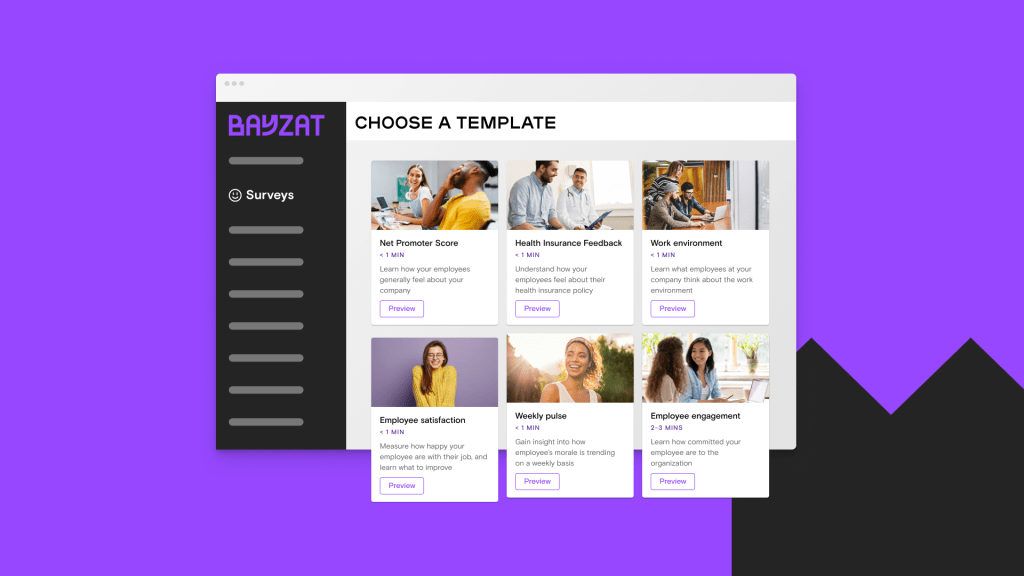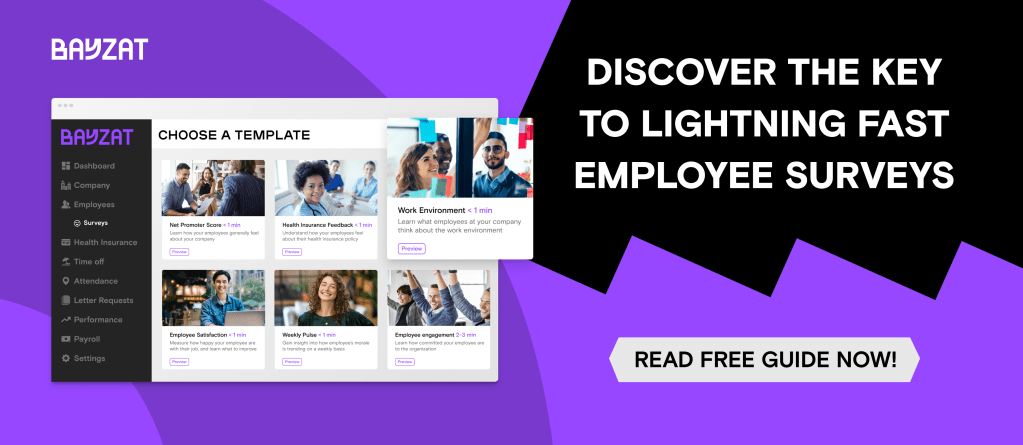Employee engagement has exploded in recent years in terms of importance. But the word isn’t a meaningless buzzword. With the correct type of employee engagement, you could achieve higher productivity, better worker retention rates and, ultimately, increase your bottom line.
This guide will examine employee engagement, how to measure and what strategies to implement. We will also explore all these issues through the unique lens of a UAE business. The region’s HR professionals have a set of challenges to overcome if they want to keep at it with positive employee engagement. So let’s get started!
Understanding Employee Engagement
“Employees who believe that management is concerned about them as a whole person – not just an employee – are more productive, more satisfied, more fulfilled. Satisfied employees mean satisfied customers, which leads to profitability.”
– Anne Mulcahy –
You can ask a room of CEOs and HR managers about employee engagement, and you’ll probably end up with various answers. There are many ways to define employee engagement. Some people think it’s all about keeping employees busy. In contrast, others might view it as a metric for keeping workers happy.
What is Employee Engagement?
Employee engagement encompasses various aspects, but its fundamental essence lies in the emotional dedication employees have toward their work and the overarching objectives of the organization. It goes beyond mere affinity for the workplace and emphasizes active participation and involvement in one’s job. Employee engagement is about demonstrating a specific, engaged behavior within the workplace rather than simply having a positive sentiment toward it.
Once you engage employees in a certain way, you’re bound to notice it. An engaged workforce will generate more value for your business.
Benefits of employee engagement
Businesses can unleash various benefits by employing strategies that build employee engagement. These are:
Engages employees are more productive.
Time and again, studies have shown that engaged workers are more productive than disengaged workers. It makes common sense, right? Why should your employees go the extra mile if they don’t feel invested or part of the team? There is no need to do anything out of the ordinary if you have no incentives.
Engaged workers stay put longer.
Employees are also more likely to stay with an organization if they are engaged. You can achieve a higher employee retention rate by engaging your team more. Again, if you feel you have room for growth and your employer values you, you don’t need to look for places elsewhere.
Engaged employees make better customer servants.
Satisfied employees will lead to happy customers. You’ve probably seen this in action, too! Suppose you’re being served by a worker who is not interested in being there. In that case, you don’t feel valued as a customer – even if there’s nothing wrong with the product! But when doing business with an engaged and enthusiastic worker, you are also more invested in the company!
Engaged employees have lower absenteeism.
Your mood and mind can have a significant impact on your physical body. If you’re happy, you’re more likely to be healthier, which can help you avoid getting sick. Engaged workers who are happy and satisfied at work tend to need less time off work, and they might not get sick as easily and are generally less likely to be burnt out.
Engaged employees increase the bottom line.
Much of the above comes down to better profits. Employees are more productive, they need less time off, and they lead to happier customers. All of it will lead to higher profits and savings for your business.
With such benefits, you’d be a fool not to venture into employee engagement!
Measuring employee engagement

You should understand how engaged your workforce is before you charge into making changes. Knowing how to measure employee engagement is vital to see if your strategies are working.
You can measure employee engagement through various employee surveys. Receive regular feedback on how employees feel about a set of topics. Do they understand the company values? Can they see a future within the organization?
You should also look into the actual ROI for engagement projects. Are you increasing productivity? Do your employee growth strategies yield higher retention rates? Stay on top of the key performance indicators to understand what is happening with engagement.
Leading factors affecting employee engagement
Employee engagement is vital; if your workforce is engaged at work, you’ll reap plenty of benefits. So why doesn’t every workplace have higher employee engagement? It’s because of the many pitfalls of the modern workplace that can hinder engagement. The top reasons workspaces aren’t as engaging as possible are:
- Organizational culture and values – Organizations often have a terrible work culture that may put things like profit and results higher than employee engagement. Businesses can also have values that don’t align with higher engagement. If the core culture and organizational values are out of whack, you can’t expect employee engagement to be positive.
- Leadership and management style – Similarly, leadership and management styles can be a big part of the system. If managers don’t care much about their employees and decisions are constantly rolling in from the top, they can overlook their employees. If people feel the leadership doesn’t care about them, why should they care about the business?
- Employee recognition and rewards – Each one of us wants to feel valued. It’s not the only driver for most of us, but if you’re putting 200% of effort into everything without ever getting as much as a thank you, you will burn out. If you reward people for the wrong things instead of actual effort and positive impact, you won’t nourish the correct type of employee behavior.
- Work-life balance – Most of us have realized – especially after the pandemic – that life is much more than just grinding away at work. Employees will burn out if they feel all their lives are is work, work, work! A workplace that can help employees build a healthy work-life balance can see a much happier workforce.
- Opportunities for growth and development – Is your organization one where it’s hard to climb up the career ladder? If so, then you may be creating a disengaged workforce. People want to grow and develop. Workplaces that offer various career growth options and opportunities will have more engaged employees.
- Communication and feedback – One of the best ways to engage anyone is by communicating with them. Our relationships are built on all sorts of conversations and feedback. If communication is one-way and feedback is only from the managers to the employees, you will run into a problem of talking to one ear and having the message go out through the other.
Strategies to Improve Employee Engagement
So what are the best strategies to help boost worker engagement in the workplace? Let’s look at some of the best methods to use:
1. Opportunities for professional development and career advancement.
Invest in professional development. Provide access to professional courses or organize workshops to inform your employees of any industry developments. Remember that investment in professional development will help your business by nurturing talent.
You also want to ensure employees know career paths within the business. Always look for in-house talent first before you start recruiting. You want employees to feel like they have a future in your organization.
2. Offer competitive compensation and benefits packages.
Your compensation must reflect the value you expect from your workers. You don’t want to create a situation where employees don’t feel like adding value because you don’t acknowledge that in the paycheck.
It’s also worth remembering that pay isn’t the only form of compensation. Your benefit package can also provide a lot of benefits. Things like health insurance, OTP, or a good holiday package can be a great way to compensate your workers.

3. Encourage work-life balance.
Encourage your employees to maintain a healthy work-life balance. Ensure you don’t ask employees to work overtime all the time. Consider offering flexible work arrangements and ensuring employees have access to regular time off. You can even provide access to schemes like gyms or hobby clubs to ensure your workers don’t only think about work!
4. Foster open communication and feedback channels.
Communication is a two-way road, as is feedback. Make sure you let employees provide input and suggest ideas concerning the direction the company is taking. Cut down the jargon and avoid talking simply to say something!
5. Recognize and reward employees for their contributions.
Recognize employees when they do the ‘right’ thing. If they reach goals, perform better than expected or achieve a significant milestone, make sure it’s noticed and rewarded. There are many ways to reward employees besides monetary bonuses and pay rises. You can gift them extra time off, allow them to pick their projects or get involved in new schemes. Remember that recognition doesn’t always have to be something huge. It’s often enough to notice the effort someone put in!

Challenges to Employee Engagement for UAE Businesses
The above overviews the typical employee engagement pitfalls and the strategies to overcome those. But businesses in UAE have a unique set of challenges to overcome. These are:
- Cultural differences and diversity – UAE workforce is multicultural, and diversity can be challenging to manage. Employees from different cultures have different attitudes to work, and what may work with one may not be as effective with another. But employees have said UAE companies lack proper culture, especially when companies fail to measure its impact.
- High turnover rates – For years, UAE businesses have had to deal with high turnover rates. Even in a recent Gallup poll, only 55% of UAE workers said they would stay with their current employer in a year. This is a slight increase from previous years, but it is still higher than elsewhere in the world.
- Limited opportunities for career growth – In that 2022 Gallup study, 48% of employees said they have adequate growth opportunities at their current company. While this is an improvement from 32% in 2019, over half of UAE workers don’t feel their businesses offer growth opportunities.
- Limited work-life balance – The work culture in UAE has a reputation for being hard. People often come to the region to earn money and get their foot through the door but then move elsewhere when the going gets tough. Usually, the big reason is the lack of work-life balance and the inability to balance family life, for example.
- Poor communication channels – Some of the big complaints UAE employees have is down to communication or lack of.
While HR and employee engagement have improved a lot in recent years in the region, persistent issues remain. It’s vital for companies to keep working towards a better tomorrow.
Best Practices for Employee Engagement in UAE
So what can UAE businesses do to improve their workplace? Here are some of the best practices to keep in mind when creating employee engagement:
1. Prioritize employee engagement as a strategic goal
Put employee engagement at the core of your business. Employee engagement should be as big of a priority as growth.
2. Create a comprehensive employee engagement plan
Set engagement goals and start measuring how engaged your workforce is. Communicate these objectives to your workers and get the whole organization on board. Ensure you are regularly analyzing your current path and adjust as needed.
3. Invest in employee training and development
Look into ways to offer employees opportunities to grow. These can be industry-specific courses as well as workshops on leadership and other soft skills. Have a clear career path available for each employee and revise it as the years go by. Remember that you also don’t want to impose training on employees – actively engage them in creating courses and get feedback on what they’d like to learn.
4. Offer competitive compensation and benefits package
Make sure your compensation and benefits package is up-to-date. Ensure it reflects the value you are getting and sort out things like healthcare insurance, holiday pay and other benefits. Use HR tools that engage employees to be part of the management of these packages.
5. Encourage work-life balance
Give employees time to rest and enjoy life. Make sure your communication isn’t always just about work. Arrange fun out-of-office activities and consider offering flexible working hours. Support your employees and be part of their life – whether it is celebrating the birth of a child or a new house!
6 . Foster a culture of open communication and feedback
Above all, make sure communication is a two-way street. You want it to be easy to contact your management and HR, giving employees the opportunity to not just only receive feedback but also give it through employee surveys. Implementing these top 10 ways to enhance coaching culture in your organization” can greatly contribute to fostering this open communication environment.
Employee Engagement Is Vital for UAE Businesses
As the 2022 Gallup study shows, UAE businesses have managed to increase the percentage of employees who feel engaged from 19% in 2019 to 30% in 2022. It is a clear indicator that organizations in the region understand the many benefits employee engagement can bring. But there are still plenty of hurdles to overcome. By prioritizing engagement as a strategic goal, businesses can keep on the right trajectory.
So take a critical look at your current employee engagement, set goals for the future and start measuring workplace engagement today!

FAQs on Employee Engagement
Q.What is employee enagagement?
Answer – Employee engagement is the emotional commitment and active involvement of employees towards their work and the goals of the organization.
Q. How does employee engagement impact organizational performance?
Answer – Employee engagement positively influences organizational performance by increasing productivity, innovation, and customer satisfaction.
Q. How can employers promote employee engagement?
Answer – Employers can promote employee engagement by fostering a positive work culture, offering growth opportunities, and providing recognition and feedback.








Get Social